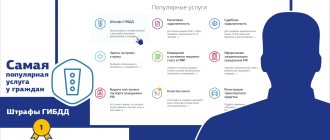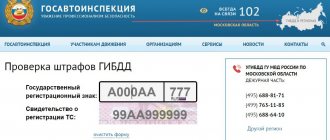Where do the fines come from?
If a traffic violation was recorded on camera, then the culprit driver must be held responsible, of course, if he is officially warned about it.
Not only the traffic police is engaged in sending out “penalty packages”. Information can be found from the State Services portal, Sberbank mobile application, etc.
So, information about violations from cameras can come:
- In the form of a notification from the State Services website to the official email of the car owner. Naturally, on the site you need to register in your personal account and confirm your identity. Without waiting for the mailing, you can periodically check the status of the fines yourself.
- SMS notification to a Sberbank client using the Online service. And also from other large banks, if connected.
- At the registered address of the car owner. The letter must be registered. Therefore, if the letter was sent to a different address or it is not registered, then the driver is not considered notified and theoretically may not pay the fine. True, bailiffs will sooner or later notify you of such a fine.
The postal notification arrives late, which is clearly disadvantageous for the driver for many reasons (the discount period on fines is lost, the bank account may be frozen, a ban on traveling abroad is possible). Often a person does not live at the registered address and may not find out about the letter at all.
Therefore, the driver can use other sources to find out the issue with the fine.
How is a fine entered into the traffic police database?
The main source of information about the presence of a fine is the unified traffic police database, which stores information about all current offenses on the road. This information repository contains detailed information not only about the car, but also its owner, including all cases of violations and fines.
Attention! If you have any questions, you can chat for free with a lawyer at the bottom of the screen or call Moscow; Saint Petersburg; Free call for all of Russia.
As a rule, there are no problems with identifying and paying through the official traffic police portal. However, due to technological failures, information about some fines appears in the database much later, preventing the receipt from being paid immediately. You should not rush to pay a fine if there are no records of it in the database on the traffic police website. The fact is that the fine payment made by the car owner may go into unidentified payments.
According to the established rules, information about the decision made and the amount of the fine appears in the traffic police database as soon as the information is received and processed. In some cases, a record of a violation appears instantly, and in some situations, information appears after several weeks or even months.
The law provides for a 3-day period for filing and sending a postal notice of a fine. If the violation was detected using photo and video recording, a letter will be sent to the registration address, which will provide comprehensive information about the circumstances of the incident and a photograph of the car at the time of the violation. The maximum period for delivery of notification is 7 days. However, the delivery time will largely depend on how quickly the post office delivers the letter to the car owner.
Failure to receive notification of a traffic police fine by mail does not relieve responsibility for the offense committed, which means that the fine must be paid within the time limit allowed by law. It should be taken into account that violations recorded by the camera will appear in the database according to the license plate number of the car, which means that letters with receipts for payment will be sent to the car owner’s registration address.
The updated version of the traffic police website contains a simplified service for clarifying fines in the database - it is enough to indicate only the license plate number of the car to obtain complete information related to all cases of offenses on the road involving a vehicle.
Information about violations is not permanently stored in the traffic police database. It should be noted that these offenses are subject to a statute of limitations, after which the fine can be written off and removed from the database. According to the current provisions of the Code of Administrative Offenses (Article 31.5), two-year unpaid receipts are subject to write-off.
Basic ways to find out about a fine
When a fine from a camera arrives in the mail, the driver will easily understand what to do: appeal or simply pay.
But sometimes the driver can only guess that he committed a violation of traffic rules in the coverage area of the traffic camera. Or you were driving in another city, region, or unknown area, violating signs or markings. However, no notifications about the fine are received by mail.
And in order not to wonder how long it takes for traffic police fines to arrive, captured on camera, you can find out about the violation from other sources.
If you have a STS number and a driver’s license, you can find the necessary information:
- Through the Internet portal of the traffic police.
- Additional traffic police website. This site operates an SMS messaging service. When you send a message to number 9112 with the text: “Staff traffic police_car number_licence number,” you will later receive a response about the presence of violations.
- Through the State Services portal. Information is available to authorized users.
- Website for drivers "Autocode". The site is intended only for Moscow residents. You can see data on parking violations.
During what period does information about a fine appear?
- The fastest way is to enter the data into the State Services portal, the traffic police website.
- On average, notifications to users of the State Services portal and bank clients with connected “Fines” and “Autopayment” services are received within 3 days from the date of the violation.
- The first information about the fine is submitted to general databases after drawing up a resolution on an administrative offense. This period can range from 1 to 15 days , depending on the total number of other violations, the workload of traffic police officers (drawing out the material), etc.
If these services are not connected automatically, then the driver can independently dispel doubts and check whether he committed violations. To do this, you need to visit either the State Services website (through your personal account), or the traffic police website, as well as other information sources.
The approximate time frame for receiving a fine by mail to your registration address is 20-25 days .
When information about a fine appears on the traffic police website
Since drivers are aware of the fact that the postal service is not reliable, so there is no point in counting on it, they check the presence of fines themselves online. But some are not even notified how long it takes for the traffic police fine to appear online. Everything is very clear here - as soon as the fine is entered into the database, the system will immediately display it.
The storage period for information in the database is limited. Particular attention should be paid to the issue of how quickly the traffic police fines database is updated. Information in the database has a statute of limitations. The Code of Administrative Offenses, Article 31.5, states that fines that are more than 2 years old are written off, so they do not have to be paid.
But in practice this does not work, since last year they began to control the issue of paying fines much more strictly.
In addition to data on how quickly fines appear on the traffic police website, it would be useful to know about the recommended payment period within 12 days. This period is a grace period. It is recommended to pay no earlier than 3 and no later than 7 days after the violation. If the payment is made very early, the systems may not recognize it; if it is late, the payment may not arrive on time and will be overdue.
Experts recommend that drivers periodically check the traffic police database, because there are cases when the driver himself does not even realize that he has committed a violation. For example, he parked against the rules.
Today's video surveillance cameras detect the oncoming traffic, the intersection of a double solid line, and the moment when a car did not allow a pedestrian to cross the roadway at an unregulated crossing.
How to request data
Traffic police website
On the website, in the “Checking fines” section, you must enter the state number and details of the vehicle certificate. The online service will check the car for all fines and provide information.
It’s impossible to say exactly how long it takes for a fine to be sent from cameras to the traffic police website. Since the information comes after the decision is made and with the next update of the data on the traffic police website.
Accordingly, it may turn out that the information will be either earlier or later than the postal notification. But still somewhere in the same period.
State Services Portal
In order to fully use the site resource, you need to register (create your personal account).
After which, by logging into the site under your name, in the “Car and traffic fines” section you can find information about fines or the absence thereof.
For state leagues, information comes from TsAFAP data, that is, promptly. There will be no fundamentally new information there. But many people find it more convenient to use the portal, since they can immediately pay the collection amounts there.
Bailiffs
Information about fines is also concentrated in the “Bank of Enforcement Proceedings” service. True, the information there is not entirely up-to-date. As a rule, information appears there when the period for voluntary repayment of the fine expires, that is, after 70 days from the date of the decision. And, nevertheless, if you promptly pay the presented amount (you can directly from the bailiff’s website, there will be a payment button next to the fine amount), then you can avoid any troubles in the form of seizure of property, blocking of a bank card, etc.
Other services
Now information about the fine can also be obtained from specialized commercial sites. There are plenty of similar Internet resources.
How to check fines in the traffic police database?
Any citizen who has the necessary information about the car and its owner can access the traffic police database, which is why there are many third-party services for checking fines. You also need to enter your data in them, and they will provide the same result as the traffic police website. Some drivers will find it more convenient to use such a third-party resource rather than the official website of the State Traffic Inspectorate.
Here are some reliable ways to check fines:
- official website of the State Traffic Inspectorate - https://GIBDD.RF/check/fines;
- state portal “State Services” – https://www.gosuslugi.ru or mobile application;
- municipal website "Avtokod" for vehicles registered in Moscow or the Moscow region - https://avtokod.mos.ru;
- checking fines on the Yandex.Money website - https://money.yandex.ru;
- separate mobile application “Yandex.Fines” for Android and iOS;
- checking fines through personal accounts of some banks - https://online.sberbank.ru, https://www.tinkoff.ru/login and others.
Payment of the fine before receiving the letter
If you use the services of the State Services portal or the Sberbank service “Autopayment of traffic police fines”, “Notification of fines”, then the account details where the fine should be paid are generated automatically and very quickly.
To take advantage of the 50% discount , you must pay the fines within 20 days from the date of the decision. Therefore, if you agree with the fine, you don’t have to wait for the letter and pay as soon as the message arrives.
If a citizen does not use these services, then you can find out your bank details on the traffic police website or by calling the regional TsAFAP.
How not to lose the discount period if the fine from the camera arrives later than 20 days later?
So, we know that most traffic police fines can be paid with a 50% discount within 20 days after the date of the decision. “Stop,” you say, “if the period begins from the date of the decision, then what if the letter arrives later?!”
Exactly! If the fine from the camera arrives after 21 days or later, then you may miss the deadline and will have to pay the fine in full. But why wait for a letter when you can look up fines on official websites, apps and many other places. Thus, the official website of the traffic police allows you to check the fine without registration and in just a few clicks; Government services allow you to subscribe to fines by Email and even by SMS (SMS messages arrive promptly and correctly). Also, many smartphone applications in 2021 are able to notify their users about new fines.
Something else useful for you:
- Why can there be a traffic police fine of 250 rubles?
- Why can there be a traffic police fine of 15,000 rubles?
- When will cameras start recording fines for driving without compulsory motor insurance and where will they be located?
Thus, you will be able to receive information about fines in a timely manner, as soon as it appears in the traffic police database and the databases of the specified sites are updated. And this will happen much earlier than the fine arrives to you by letter - you will learn about new fines literally a day or two after the decision is made and will be able to pay them at a discount.
How fines arrive in the mail
To understand how quickly letters of happiness arrive, it is enough to know the stages of the administrative procedure.
Receipt of materials to TsAFAP traffic police
From a stationary camera, materials about violations are sent to CAFAP automatically in real time.
If the recording camera was mobile or portable, then the employee responsible for it provides materials within 1-2 days after the violation is detected.
Review by CAFAP
The material is reviewed for approximately 1 - 1.5 weeks, but no more than 15 days. The consideration ends with the drawing up of a resolution.
If errors and inconsistencies are identified (for example, unreadable numbers), the administrative check is terminated.
Sending to the violator
The assembled package (decree, photographic material and receipt) is sent by registered mail, which takes 2-3 days to reach the addressee. That is, the car owner will receive a notification in the mailbox or personally from the postman 4-5 days after sending.
If the owner of the car is from another region, the postal service will increase delivery by 5-10 days.
Of course, there may be hiccups at each stage, which may lead to a slight increase in time.
Notice of fine payment
Recently, CAFAP departments have begun sending out notices of unpaid fines to violators.
A traffic police officer monitors the status of the fine in the database and if he sees that the fine has not been paid within 20 days (that is, during the period when the 50% amount is provided), then a reminder is sent to the driver. Although no one really knows exactly how many days such a notification will be sent.
The essence of the notification is to inform about the presence of an outstanding fine and, in case of refusal to pay, they offer to report to a TsAFAP employee after 70 days to draw up a protocol under Art. 20.25 Code of Administrative Offenses of the Russian Federation. That is, they will be subject to a double fine for failure to pay the main amount.
If such a notice was received, but you did not know about the fine, then you need to write a letter to TsAFAP about re-providing copies of materials from the video recording camera. And only after making sure that such a case really happened can you pay the bill.
What violations does the camera record?
To understand what possible violations are possible and how not to delay payment or appeal, you need to know what fines come from the cameras. Traffic cameras detect the following violations:
- movement speed;
- parking;
- seat belts;
- passage of pedestrian crossings;
- intersections of solid lines, stop lines, tram tracks;
- driving in the public transport lane;
- incorrect passage of controlled intersections;
- driving on the side of the road;
- prohibited or incorrect maneuvers (turning, turning, reversing, etc.);
- use of prohibited xenon headlights;
- and others.
The most common is a fine for speeding from a camera.
In this case, the design of the technical means, the method of its application, etc. are not important.
The rules for recording a violation, drawing up a resolution and sending materials to the culprit, as well as the payment terms, are the same. That is, no matter which camera the fine came from, the procedure is the same for all cases.










